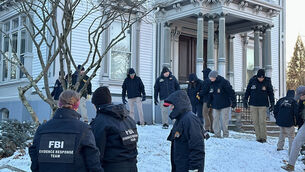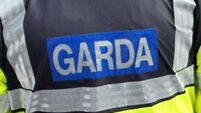Scavengers scour wreckage of plane
Hundreds of scavengers swarmed over the wreckage of a Peruvian airliner early today, potentially undermining the work of investigators en route to the crash that left at least 37 dead.
Dozens of soldiers stood by and watched as residents of this Amazon jungle town searched through the debris for anything of value.
“I’m collecting this for my house to hang my laundry,” said Rosario Dahua, 47, as she tugged at a tangle of heavy black wires next to a partially submerged turbine jet motor wedged in the water and mud.
Air Force Cmdr William Rodriguez, who is in charge of security at the site, said he did not believe the residents’ actions would impede the work of civil aviation investigators who have yet to arrive.
“We are verifying that all the bodies have really been recovered,” Rodriguez said. “So if these people want to search for things, perhaps they’ll encounter another body.”
The TANS Airline Boeing 737-200 was carrying 98 people, including six crew members, on a domestic flight from the Peruvian capital of Lima to Pucallpa when it crash-landed on Tuesday in a marsh a few miles from the Pucallpa airport, killing at least 37 people, including four crew members, company spokesman Jorge Belevan said yesterday.
At least 58 people survived the crash, the fifth this month worldwide, making August the deadliest month for world airline disasters in three years.
Among the survivors were six members of the Vivas family from Brooklyn, New York who recounted how, upon escaping the wreckage and fleeing into a hail storm, they rescued a baby boy in the mud.
“My uncle told us: ’Let us pray’ and we were silent,” said Joshelyn Vivas, 15. “Hail was coming down on us and we went into like a cocoon around the baby.”
“We jumped out the plane and unfortunately we were thigh deep in the marsh water. It was just mud,” said the girl’s uncle, Gabriel Vivas, a 41-year-old manager of an electronics rental shop. “We had to practically crawl out of there and try to get to some high ground.
“There was a baby that I saw behind the plane. I don’t know how the baby got there, but he was fine,” Gabriel Vivas said.
TANS airline said wind shear may have forced the pilot’s emergency landing.
Belevan said three missing people might include survivors from Pucallpa who returned to their homes after the crash without receiving medical assistance.
Television images of the crash site showed mutilated bodies being retrieved from a marsh near the Pucallpa airport where the pilot attempted an emergency landing. The fuselage was shattered and pieces strewn along a 500-metre path made by the plane as it crash-landed.
“A plane is totally destroyed and more than 50% of the passengers have survived,” John Elliot, an experienced Peruvian pilot and aviation expert, said. He called it “a miracle”.
Gabriel Vivas was visiting his Peruvian homeland with his wife, Diana, 43, and his older brother, Jose Leandro Vivas, a New York City transit system toll collector, who had also brought his three daughters.
“It was raining and I saw all these black clouds. I knew something was going to go wrong,” said Diana Vivas, fighting back tears.
Gabriel Vivas said the captain had told the passengers to buckle their seat belts for landing when the plane made three sudden turbulent descents and crashed.
The family was seated in the rear of the aircraft, which, unlike the front, remained largely intact as it skidded across the marsh field. When it came to a stop, a flight attendant opened a rear door and urged passengers get out, the family said.
Gabriel said that he and another man saw a baby boy perhaps a year old behind the plane.
“He picked up the baby and we tried to get to higher ground. He got stuck in the mud and then I grabbed the baby. Then he jumped in front of me to push away the thorns that were in our way.
"Between us we got the baby to higher ground with everybody else,” he said.
Joshelyn Vivas said the family didn’t know if the baby’s parents had survived the crash but were told he had been brought to Lima and was alive.
Joshelyn’s father said the purpose of the family’s visit was to celebrate her 15th birthday – which was on Monday – a traditional right of passage for teenage girls in Peru.
“To me this was a shocking (birthday) present, like I was so scared but at least I came through it,” Joshelyn said. ”This present gave me a lot of bravery now.”
The pilot began his approach to the airport in torrential rains and strong winds, which passengers said began rocking the plane 10 minutes before the scheduled landing.
But four miles from the airstrip he attempted to make an emergency landing, TANS said, after wind shear apparently pushed his plane close to the ground.
The pilot apparently aimed for the marsh to soften the impact, but the aircraft broke apart in the landing, strewing pieces of fuselage as it skidded over the boggy ground.
Belevan credited the pilot’s skill for saving so many lives.
But Elliot and Victor Girao, a former president of Peru’s Association of Pilots, said the crash appeared to be due to pilot error. Elliot said the pilot should have opted to avoid the storm and land at another airport.
Both said the pilot was flying too close to the ground while making the approach to the airport from four miles out, making it difficult to control the aircraft against wind shear.
“They were coming in very low, looking for the airstrip. A big beginners’ error,” Girao said.
Search teams have recovered the plane’s cockpit flight data recorder, said Pablo Arevalo, a prosecutor in Pucallpa.
Belevan said there were 18 foreigners aboard the aircraft – 11 Americans, four Italians, one Colombian, one Australian and one from Spain.
Among the dead were at least four foreigners – an American man and woman, a Spanish woman and a Colombian woman.
Airline accidents in Venezuela, Greece, Italy and Peru this month have killed 334 people. The previous deadliest month was May 2002, with three major crashes that killed at least 485.













